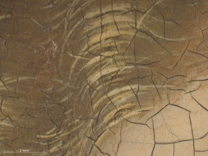
View enlargement in Image Viewer
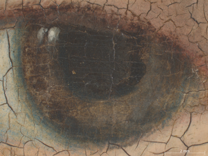
View enlargement in Image Viewer
Description
The bright green background is framed in a brownish, possibly wooden, moulding. The child's hair is highlighted in dull orange-yellow (fig.14). The irises of her eyes appear to be grey with blue arcs next to the pupils (fig.15). The semi-transparent coif beneath her hood is patterned in yellow, representing embroidery with gold threads (fig.16). The hood itself, thickly sewn with pearls (fig.17), is tied under her chin; the pattern on the snood is similar, but not identical, to the pattern on her sleeves. Her shirt is edged with a looped rope of gold thread. Around her neckline are large pearls sewn onto pieces of fabric ornamented with gold threads. There is a blue stripe between the ornamented fabric and the red bodice. The bodice has become slightly less intense in colour because of the fading of the red lake; it was probably intended to be a richly-coloured red velvet.
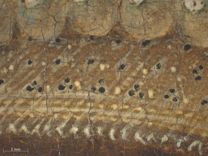
View enlargement in Image Viewer
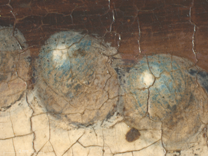
View enlargement in Image Viewer
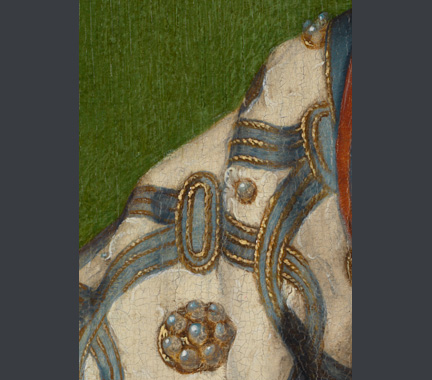
View enlargement in Image Viewer
The sleeves, sewn with single pearls and pearls grouped in eights, are decorated with patterns of interlocking purple (now blue) bands of appliqué sewn with ropes of gold thread (See fig.18 above, and photomicrographs m13 – m18 in Image Viewer). At the wrists, pearls are sewn to the purple bands and strung in three ropes above the cuffs, themselves decorated with frills edged with ropes of gold thread. The belt incorporates yet more large pearls (See photomicrographs m33 – m35 in Image Viewer).
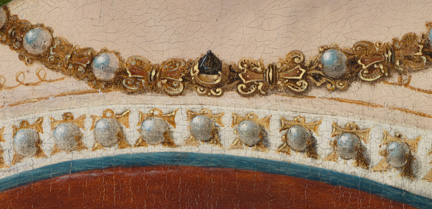
View enlargement in Image Viewer
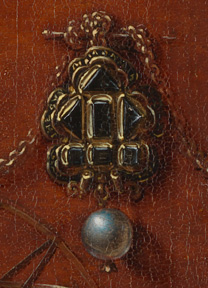
View enlargement in Image Viewer
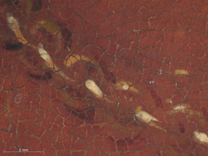
View enlargement in Image Viewer
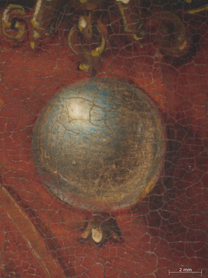
View enlargement in Image Viewer
The central jewel in her golden necklace (fig.19) is a point-cut diamond (See photomicrograph m27 in Image Viewer), surrounded by red stones (See photomicrograph m28 in Image Viewer) and large pearls. The gold chain (fig.21) is twisted around a golden pin from which hangs a pendant in a golden setting (fig.20). Around its edges are inscriptions referring to Christ, and possibly also to the Virgin; the seven stones, three triangular, one rectangular and three squarish, are all diamonds. An enormous pearl hangs down from the pendant (See fig.22 right, and photomicrograph m29 – m31 in Image Viewer).
In her left hand the child holds, upside down, a small armillary sphere, made of brass or possibly gilded (See fig.23 below, and photomicrographs m38 – m40 in Image Viewer). The Latin ‘armilla’ means bracelet; the hoops of the skeleton sphere show the motions of the heavenly bodies. The broad diagonal band of the ecliptic would normally have run on the other diagonal and would have been decorated with the signs of the Zodiac and the names of the months. Here it is instead marked with letters which form an anagram of the artist's name (See fig.1, and photomicrographs m41 – m48 in Image Viewer). The vertical rod is the celestial axis, the small globe at its centre is the earth, and the horizontal rings mark the Arctic and Antarctic circles, the tropics and the equator. The second diagonal hoop is unusual but may be meant for a horizon ring (compare fig.24).12 The child, touching with her right hand the outer ring of the instrument, indicates a point approximately 55° north of the equator.
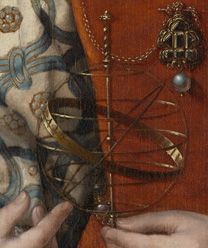
View enlargement in Image Viewer
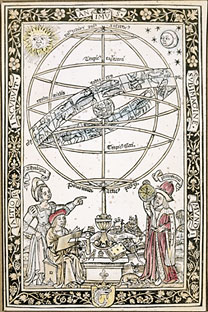
Further Sections
- Introduction
- Inscriptions, provenance, exhibitions and version
- Technical notes
- Description
- Attribution and date
- The identity of the sitter
